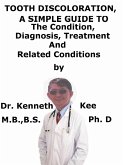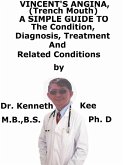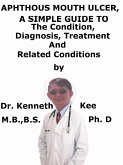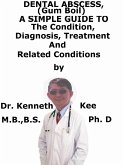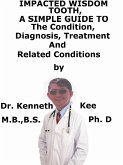Anomalous tooth color is any color other than white to yellowish-white.
Many substances can cause teeth to become discolored.
The alteration in color may affect the entire tooth, or it may become visible as spots or lines in the tooth enamel.
Enamel is the hard outer layer of the tooth.
The patient may develop poor self esteem due to his tooth discoloration
Causes
The genes can affect the tooth color.
1. Dentinogenesis imperfecta
2. Amelogenesis imperfecta
Other illnesses that can cause tooth color changes are:
1. Diseases that is present at birth
2. Inherited disorders may affect the thickness of enamel or the calcium or protein content of the enamel.
Environmental factors
1. Infections
2. Metabolic diseases may cause changes in tooth color and shape.
Tooth discoloration can be caused by:
A. External factors staining the outer layer of the tooth are
1. Smoking,
2. Beverages such as coffee, wine, cola
3. Foods such as apples and potatoes.
B. Internal factors involve the inner structure of the tooth (the dentin) causing it to darken or become yellowish through:
1. Excessive exposure to fluoride during early childhood:
Too much fluoride from environmental sources (natural high water fluoride levels) or overuse of fluoride rinses, toothpaste, and fluoride supplements
2. Tetracycline antibiotics use during the second half of pregnancy and children 8 years old or younger (tetracycline usage before age 8).
3. Tooth injury in a child with injury to the developing permanent tooth.
4. Systemic illness during tooth formation such as hemolytic disease of the newborn
5. Aging discoloration - the dentin becomes yellow naturally with aging making the teeth look discolored.
6. Infection (dental caries) leads to grayish discoloration.
Treatment is dependent on the cause of the discoloration and may be:
1. Proper tooth hygiene -proper tooth brushing and flossing methods
2. Avoiding foods and beverages that can cause stains
3. Micro-abrasion of the stains on the outer surface of teeth
4. Bonding -tooth can be enclosed with a color-matched composite bonding material
5. Veneers are color-matched thin ceramic shells that cover up the outer surfaces of the teeth.
6. Application of a bleaching agent to the enamel of the teeth.
1. Bleaching.
This is most frequent form of teeth whitening procedure.
Bleaching is done by placing a gel or rubber to shield the soft tissue of the gums.
Most teeth whitening products usually contain carbamide peroxide and hydrogen peroxide as the active ingredients.
Non-vital bleaching is suggested for the treatment of teeth with discoloration due to pulpal degeneration.
This method requires placing a mixture of 30% hydrogen peroxide and sodium perborate into the pulp chamber for a length of 1 week
2. Laser Whitening.
This is also known as the power whitening.
The laser will then be used to activate the chemical.
The light will help increase the chemical reaction of the bleaching product thus the color change can be obtained more quickly.
3. Veneers
Veneers are thin custom-made shells made of tooth colored materials planned to cover the front side of the teeth to enhance the overall the white look of teeth.
They are produced from thin plastic resin or porcelain.
4. Home remedy teeth whitening system are normally used to obtain the healthy smile result.
Instructions are provided on how to make and use DIY tooth whitening.
TABLE OF CONTENT
Introduction
Chapter 1 Tooth Discoloration
Chapter 2 Causes
Chapter 3 Symptoms
Chapter 4 Diagnosis
Chapter 5 Treatment
Chapter 6 Prognosis
Chapter 7 Dental Decay
C...
Dieser Download kann aus rechtlichen Gründen nur mit Rechnungsadresse in A, B, CY, CZ, D, DK, EW, E, FIN, F, GR, H, IRL, I, LT, L, LR, M, NL, PL, P, R, S, SLO, SK ausgeliefert werden.



